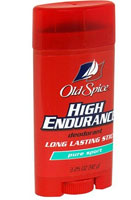Difference Between Deodorant and Antiperspirant
 Deodorant vs Antiperspirant
Deodorant vs Antiperspirant
It’s the end of a long, hot day. You’re leaving work, jammed into the elevator when suddenly you get a whiff of what smells like stale corn chips. It is body odor. While entirely natural and not necessarily the product of poor hygiene, body odor is not a pleasant odor. For thousands of years humans have looked for ways to cover up, suppress, or otherwise eliminate body odor. Covering it up involves the continual application of perfume or cologne, a method very common in earlier times. However, today there are more sophisticated ways to eliminate body odor, specifically by using a deodorant or an antiperspirant.
Definition of Deodorant and Antiperspirant
Deodorant ‘“ is classified by the Food and Drug Administration of the United States as an over the counter cosmetic medication that is used to eliminate body odor. With this broad definition, both perfumes and antiperspirants fall into the deodorant category, however, as you will see, deodorant’s specific application differentiates it.
Antiperspirant ‘“ is technically a kind of deodorant that suppresses body odor by preventing sweat from occurring in the areas of your body, such as your armpits, where body odor is most likely to occur.
How Deodorant and Antiperspirant Work
Deodorant ‘“ attacks on side of the body odor equation, the bacterial side. Body odor is caused by bacteria acting as a fermenting agent on your sweat. If you have ever taken a brewery or winery tour you will notice the distinctive smell coming from the fermenting vats. This process is taking place underneath your arms, though on a smaller scale. If the bacteria are killed then the fermentation will not take place. No fermentation means no odor.
Antiperspirants ‘“ may also have a deodorant property to them, but they mainly work to stop you from sweating in the first place. This then gives the bacteria nothing to ferment.
Types of Deodorants and Antiperspirants
Deodorant ‘“ kills bacterial through a number of ways. It may be a spray or aerosol product that contains alcohol that will temporarily kill bacteria. It might be a roll on or gel that contains an antimicrobial metallic compound. There are roll on deodorants made with naturally anti-microbial hops.
Antiperspirant ‘“ uses various forms of aluminum to block the production of sweat. Aluminum reacts with compounds on the surface of your skin to form a kind of plug that blocks your pores.
Safety of Deodorants and Antiperspirants
Deodorant ‘“ is considered to be relatively benign, especially if hops are used.
Antiperspirant ‘“ while FDA approved is considered less healthy as it stops your body’s natural cooling down process of sweating.
Summary:
1. Deodorants and antiperspirants are used to stop the smell of body odor that is created by a combination of bacteria and sweat.
2. Deodorants attack odor causing bacteria to eliminate smells whereas antiperspirants prevent your body from sweating and therefore keeps you both dry and smell-free.
3. Deodorants are considered to be safer than antiperspirants because they don’t stop the body’s natural method for cooling down.
- Difference Between Schizophrenia and Psychosis - March 7, 2024
- Difference Between African and Asian Elephants - March 7, 2024
- Difference Between Sunscreen and Sunblock - February 15, 2024

My spouse and I stumbled over here by a different website and thought I might as
well check things out. I like what I see so i am just following you.
Look forward to looking at your web page yet again.
fibreglass cooling towers